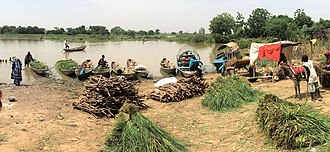Niger River






Niger River
The Niger River is a principal river in West Africa, known for being the third-longest river in Africa, after the Nile and the Congo River. With an estimated length of 4,180 km (2,600 mi), it runs in a crescent through Guinea, Mali, Niger, on the border with Benin and then through Nigeria, discharging through a massive delta, known as the Niger Delta or the Oil Rivers, into the Gulf of Guinea in the Atlantic Ocean. The Niger is an enormously important resource for the countries it flows through, providing vital water for agriculture and communities along its path.
Geography[edit]
The source of the Niger River is in the Guinea Highlands in southeastern Guinea. It runs in a crescent through Mali, Niger, and Nigeria, draining an area of about 2,117,700 square kilometers. The river's unusual route has puzzled geographers for centuries; its boomerang shape has it flowing away from the sea into the Sahara Desert, then making a sharp right turn near the ancient city of Timbuktu to head southeast towards the sea.
Tributaries[edit]
The Niger has several major tributaries:
- The Bani River, which joins at Mopti, Mali
- The Benue River, which joins in Nigeria and is its largest tributary
- The Sokoto River, which flows into the river in Nigeria
Hydrology[edit]
The Niger's flow is affected by the seasonal rains in the headwaters and the central portions of the river basin, leading to a flood season from September to May in the upper parts and a dry season from October to April in the lower parts. The river's discharge varies greatly throughout the year, with the highest flows during the wet season.
Economy[edit]
The Niger River plays a crucial role in the economy of the region, supporting fishing, livestock herding, and agriculture along its banks. In Mali, the Inner Niger Delta hosts an important irrigation-based agricultural system. In Nigeria, the Niger Delta region is one of the world's most important oil-producing regions, although this has also led to significant environmental and social issues.
Environmental Concerns[edit]
The Niger River faces several environmental challenges, including water pollution, overfishing, and the impacts of climate change. The construction of dams and increased agricultural runoff has also affected the river's flow and health. Efforts are being made to address these issues, including international cooperation to manage the river's resources sustainably.
Cultural Significance[edit]
The Niger River has been an important waterway for trade and communication across West Africa for thousands of years. It has supported several ancient African empires, including the Mali Empire and the Songhai Empire. The river's banks are dotted with historical cities like Timbuktu and Gao, which were centers of Islamic scholarship and trade in the medieval period.
Ad. Transform your life with W8MD's Budget GLP-1 injections from $75


W8MD offers a medical weight loss program to lose weight in Philadelphia. Our physician-supervised medical weight loss provides:
- Weight loss injections in NYC (generic and brand names):
- Zepbound / Mounjaro, Wegovy / Ozempic, Saxenda
- Most insurances accepted or discounted self-pay rates. We will obtain insurance prior authorizations if needed.
- Generic GLP1 weight loss injections from $75 for the starting dose.
- Also offer prescription weight loss medications including Phentermine, Qsymia, Diethylpropion, Contrave etc.
NYC weight loss doctor appointmentsNYC weight loss doctor appointments
Start your NYC weight loss journey today at our NYC medical weight loss and Philadelphia medical weight loss clinics.
- Call 718-946-5500 to lose weight in NYC or for medical weight loss in Philadelphia 215-676-2334.
- Tags:NYC medical weight loss, Philadelphia lose weight Zepbound NYC, Budget GLP1 weight loss injections, Wegovy Philadelphia, Wegovy NYC, Philadelphia medical weight loss, Brookly weight loss and Wegovy NYC
|
WikiMD's Wellness Encyclopedia |
| Let Food Be Thy Medicine Medicine Thy Food - Hippocrates |
Medical Disclaimer: WikiMD is not a substitute for professional medical advice. The information on WikiMD is provided as an information resource only, may be incorrect, outdated or misleading, and is not to be used or relied on for any diagnostic or treatment purposes. Please consult your health care provider before making any healthcare decisions or for guidance about a specific medical condition. WikiMD expressly disclaims responsibility, and shall have no liability, for any damages, loss, injury, or liability whatsoever suffered as a result of your reliance on the information contained in this site. By visiting this site you agree to the foregoing terms and conditions, which may from time to time be changed or supplemented by WikiMD. If you do not agree to the foregoing terms and conditions, you should not enter or use this site. See full disclaimer.
Credits:Most images are courtesy of Wikimedia commons, and templates, categories Wikipedia, licensed under CC BY SA or similar.
Translate this page: - East Asian
中文,
日本,
한국어,
South Asian
हिन्दी,
தமிழ்,
తెలుగు,
Urdu,
ಕನ್ನಡ,
Southeast Asian
Indonesian,
Vietnamese,
Thai,
မြန်မာဘာသာ,
বাংলা
European
español,
Deutsch,
français,
Greek,
português do Brasil,
polski,
română,
русский,
Nederlands,
norsk,
svenska,
suomi,
Italian
Middle Eastern & African
عربى,
Turkish,
Persian,
Hebrew,
Afrikaans,
isiZulu,
Kiswahili,
Other
Bulgarian,
Hungarian,
Czech,
Swedish,
മലയാളം,
मराठी,
ਪੰਜਾਬੀ,
ગુજરાતી,
Portuguese,
Ukrainian
